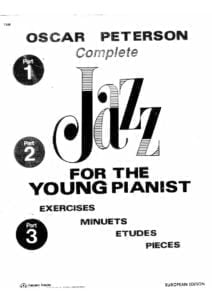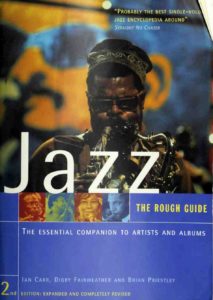Dizzy Gillespie Quintet Jazz on BBC Jazz 625 (1966) with sheet music
Dizzy’s genius as a composer, bandleader and soloist come shining through in this beautifully-restored high-quality recording.
Trumpet – Dizzy Gillespie Saxaphone/Flute – James Moody Bass – Christopher White
Piano – Kenny Barron
Drums – Rudy Collins John Birks
“Dizzy” Gillespie (October 21, 1917–January 6, 1993) was an American jazz trumpeter, bandleader, composer, educator and singer.
02:07 “And then she stopped” 07:23 – “Tin tin deo” 13:16 – Band Introduction 16:10 – “Mmm Hmm” 21:41 – “No More Blues” (Chega de saudade) 32:54 – Outro
He was a trumpet virtuoso and improviser, building on the virtuoso style of Roy Eldridge but adding layers of harmonic and rhythmic complexity previously unheard in jazz. His combination of musicianship, showmanship, and wit made him a leading popularizer of the new music called bebop. His beret and horn-rimmed spectacles, his scat singing, his bent horn, pouched cheeks, and his light-hearted personality provided some of bebop’s most prominent symbols.
In the 1940s Gillespie, with Charlie Parker, became a major figure in the development of bebop and modern jazz. He taught and influenced many other musicians, including trumpeters Miles Davis, Jon Faddis, Fats Navarro, Clifford Brown, Arturo Sandoval, Lee Morgan, Chuck Mangione, and balladeer Johnny Hartman.Scott Yanow wrote, “Dizzy Gillespie’s contributions to jazz were huge.
One of the greatest jazz trumpeters of all time, Gillespie was such a complex player that his contemporaries ended up being similar to those of Miles Davis and Fats Navarro instead, and it was not until Jon Faddis’s emergence in the 1970s that Dizzy’s style was successfully recreated [….] Gillespie is remembered, by both critics and fans alike, as one of the greatest jazz trumpeters of all time”.Gillespie has been described as the “sound of surprise”.

The Rough Guide to Jazz describes his musical style: The whole essence of a Gillespie solo was cliff-hanging suspense: the phrases and the angle of the approach were perpetually varied, breakneck runs were followed by pauses, by huge interval leaps, by long, immensely high notes, by slurs and smears and bluesy phrases; he always took listeners by surprise, always shocking them with a new thought.
His lightning reflexes and superb ear meant his instrumental execution matched his thoughts in its power and speed. And he was concerned at all times with swing—even taking the most daring liberties with pulse or beat, his phrases never failed to swing. Gillespie’s magnificent sense of time and emotional intensity of his playing came from childhood roots.
His parents were Methodists, but as a boy he used to sneak off every Sunday to the uninhibited Sanctified Church. He said later, “The Sanctified Church had deep significance for me musically. I first learned the significance of rhythm there and all about how music can transport people spiritually.”In Gillespie’s obituary, Peter Watrous describes his performance style: In the naturally effervescent Mr. Gillespie, opposites existed.

His playing—and he performed constantly until nearly the end of his life—was meteoric, full of virtuosic invention and deadly serious. But with his endlessly funny asides, his huge variety of facial expressions and his natural comic gifts, he was as much a pure entertainer as an accomplished artist.Wynton Marsalis summarized Gillespie as a player and teacher: His playing showcases the importance of intelligence. His rhythmic sophistication was unequaled.
He was a master of harmony—and fascinated with studying it. He took in all the music of his youth—from Roy Eldridge to Duke Ellington—and developed a unique style built on complex rhythm and harmony balanced by wit. Gillespie was so quick-minded, he could create an endless flow of ideas at unusually fast tempo. Nobody had ever even considered playing a trumpet that way, let alone had actually tried.

All the musicians respected him because, in addition to outplaying everyone, he knew so much and was so generous with that knowledge…Gillespie’s trademark trumpet featured a bell which bent upward at a 45-degree angle rather than pointing straight ahead as in the conventional design. According to Gillespie’s autobiography, this was originally the result of accidental damage caused by the dancers Stump and Stumpy falling onto the instrument while it was on a trumpet stand on stage at Snookie’s in Manhattan on January 6, 1953, during a birthday party for Gillespie’s wife Lorraine.
The constriction caused by the bending altered the tone of the instrument, and Gillespie liked the effect. He had the trumpet straightened out the next day, but he could not forget the tone. Gillespie sent a request to Martin to make him a “bent” trumpet from a sketch produced by Lorraine, and from that time forward played a trumpet with an upturned bell.
In April 1995, Gillespie’s Martin trumpet was auctioned at Christie’s in New York City with instruments used by Coleman Hawkins, Jimi Hendrix, and Elvis Presley. The battered instrument was sold to Manhattan builder Jeffery Brown for $63,000, the proceeds benefiting jazz musicians with cancer.
Sheet Music download.
Browse in the Library:
Or browse in the categories menus & download the Library Catalog PDF:
